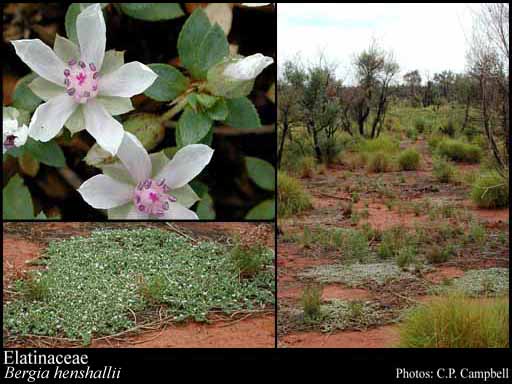- Reference
- Anal.Fam.Pl. p44, 49 (1829)
- Name Status
- Current

Scientific Description
Common name. Waterwort Family.
Habit and leaf form. (Sub-) shrubs, or herbs. Annual, or perennial. Hydrophytic and helophytic (mostly tolerant of changing water levels); rooted. Leaves submerged and emergent; opposite (and decussate), or whorled (rarely); petiolate to sessile; simple; epulvinate. Leaf blades entire; linear to ovate, or obovate; pinnately veined; attenuate at the base. Leaves with stipules. Stipules interpetiolar. Leaf blade margins entire, or crenate, or serrate. Leaves without a persistent basal meristem. Stem anatomy. Secondary thickening absent, or developing from a conventional cambial ring.
Reproductive type, pollination. Fertile flowers hermaphrodite. Unisexual flowers absent. Plants hermaphrodite.
Inflorescence and flower features. Flowers solitary (axillary), or aggregated in ‘inflorescences’; in cymes. The terminal inflorescence unit cymose. Inflorescences axillary. Flowers small; regular; 2–5(–6) merous; cyclic; tetracyclic, or pentacyclic. Free hypanthium absent. Perianth with distinct calyx and corolla; 4–10(–12); 2 -whorled; isomerous. Calyx 2–5(–6); 1 -whorled; polysepalous, or gamosepalous; imbricate; regular. Corolla 2–5(–6) (the same number as K); 1 -whorled; polypetalous; imbricate; regular; persistent. Androecium 2–5(–6), or 4–10(–12) (i.e. the same number as or twice C). Androecial members free of the perianth; all equal; free of one another; 2 -whorled, or 1 -whorled (the inner whorl sometimes aborted). Androecium exclusively of fertile stamens. Stamens 2–5(–6), or 4–10(–12); isomerous with the perianth, or diplostemonous; when 1-whorled oppositisepalous. Anthers dorsifixed; versatile; dehiscing via longitudinal slits; introrse; tetrasporangiate. Gynoecium 2–5(–6) carpelled. The pistil 2–5(–6) celled. Carpels isomerous with the perianth. Gynoecium syncarpous; synovarious; superior. Ovary plurilocular; 2–5(–6) locular (but the septa sometimes not reaching the ovary apex). The ‘odd’ carpel (when G3) anterior. Gynoecium stylate. Styles 2–5(–6) (same number as locules); free; apical. Stigmas capitate. Placentation axile. Ovules 15–50 per locule (i.e. ‘many’); horizontal to ascending; with lateral or superior raphe; non-arillate; anatropous.
Fruit and seed features. Fruit non-fleshy; dehiscent; a capsule. Capsules valvular (septifragal). Seeds non-endospermic. Cotyledons 2 (relatively short). Embryo straight to curved. Micropyle zigzag (sometimes), or not zigzag. Seedling. Germination phanerocotylar.
Physiology, biochemistry. Aluminium accumulation not found.
Geography, cytology, number of species. World distribution: widespread. X = 6, 9. 40 species.